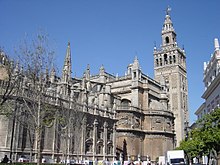List of largest church buildings in the world
From Wikipedia, the free encyclopedia
Seville Cathedral, the third largest church building in the world and the largest cathedral.
Contents
Scope
The term church is open to interpretation and debate. In this article, it means any building that was built for the primary purpose of Christian worship, for any recognised denomination of Christianity. This includes every cathedral (the seat of a bishop), basilica, and other type of church. It does not include temples of other religions, such as mosques, synagogues, and so on. It does include at least one building, Hagia Sophia, that was built as a church and later became a mosque (it is now a museum).Measurements
Whilst claims are made about the relative size of churches many of these claims are not easily substantiated. "Largest" is at best a vague term, which is often not qualified by claimants. Accepted measures of largeness could include area, volume, length, width, height, and/or capacity, although the last is far more subjective. It is important to note therefore that churches may claim to be "the largest" based on only one of these measurements; and thus that there may be several churches that have equal claim to be "the largest church". Since there is no official body governing these claims, there is no generally accepted criterion for being "the largest church".The list below attempts to rank churches by different (more-or-less) objective criteria, and thus may generate different orders depending on the measure used. Churches for which claims are made but dimensions cannot be found are not included on the below lists.
For length, width and height, there is usually a definitive statistic for each church, which can easily be compared. However, for area and volume, the situation is often more complex. It is often possible to find multiple values quoted for the area/volume of a church in references. Many values appear to be estimates or approximations (especially for volume), or may have been calculated by multiplying lengths, widths and heights. In the latter case, the exact dimensions used (internal vs. external, etc.) may give very different figures. Therefore, although area and volume are the most common 'largeness' measures, they are also apt to be the least reliable. This should be borne in mind when comparing church sizes.

No comments:
Post a Comment